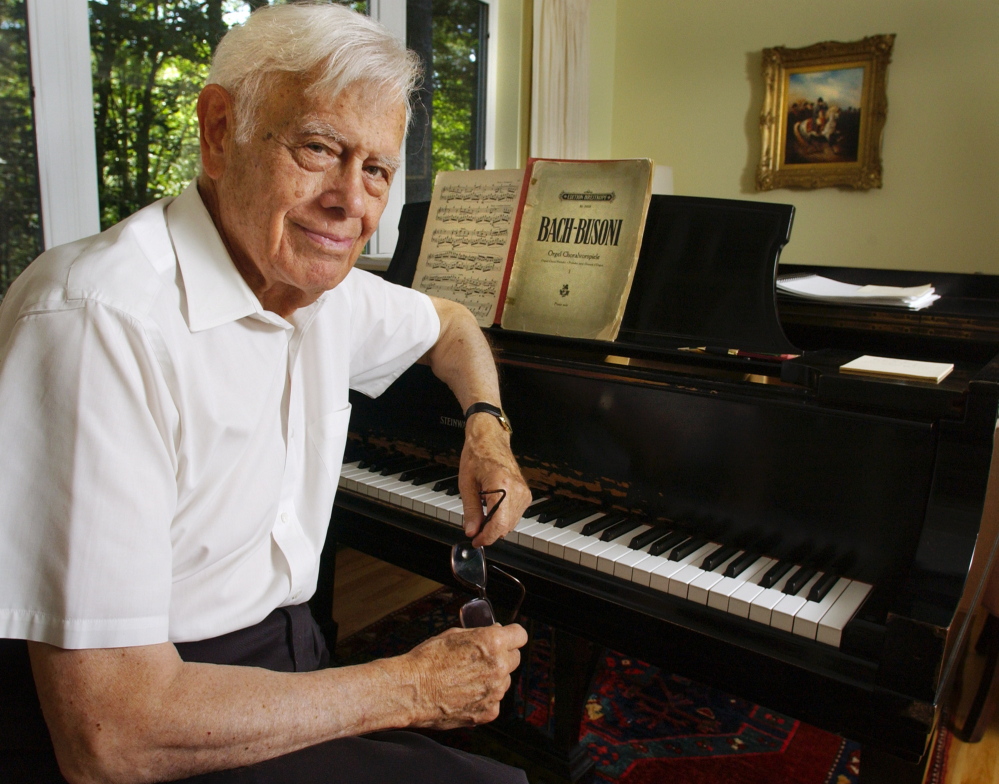At 24, the pianist Frank Glazer, later to become artist in residence at Bates College in Lewiston, had already played a Brahms concerto with Leopold Stokowski and begun a successful career, before being drafted during World War II.
As he told his student Duncan Cumming, “I wanted to approach the piano as if I had never played before.”
I spoke with Cumming following a memorial service for Glazer, who died in January a month short of his 100th birthday. I wanted to know, like most other pianists in Maine, the secret to playing like a virtuoso at age 99. And it wasn’t, like the famed directions to Carnegie Hall, “practice, practice practice.”
Glazer was not like Canadian pianist Glen Gould, who claimed never to practice at all, but had come to realize that dogged, uninformed time at the keyboard was not only counterproductive, but could actually cause physical injury. Robert Schumann, for example, ended his playing career by using a pedagogical device intended to strengthen the fourth finger. Contemporary pianists often suffer carpal tunnel syndrome and other ailments caused by long hours of repetitive physical effort. Eleven hours of practice a day is not unheard of, and eight seems to be typical.
In California, Glazer worked on “efficiency,” using only the muscles needed to play, in the most relaxed manner possible. Cumming recalls three books on Glazer’s shelf: “The Use of Myself,” a treatise on the Alexander technique of body awareness; Otto Ortman’s “Physiology of Touch and Tone”; and “Grey’s Anatomy.”
He developed a balanced approach between finger touch, often referred to as the French school, and weight touch as taught at the Eastman School of Music in which the weight of the arm creates the tone. He also taught himself piano tuning, in the process becoming familiar with the inner workings of the instrument.
Cumming describes the physical technique at greater length in his 2006 book “The Fountain of Youth: The Artistry of Frank Glazer,” but in the end he finds it an unsatisfactory explanation of Glazer’s longevity as a pianist.
“It’s a great mystery,” he says. “It also has to do with Glazer’s attitude, work ethic and generosity.”
Studying with Artur Schnabel, the great Beethoven specialist, in Germany after the war may also have contributed to Glazer’s relaxed approach to the keyboard. Schnabel was interested in technique only in so far as it influenced interpretation, lacked the showy virtuosity of many pianists of the era, and was known for his mistakes during live concerts. While the worst may never happen, the realization that one can let the notes fall where they may is a great antidote to stage fright.
In later years, Glazer, with some trepidation, began playing concerts with the score on the piano. Many concert pianists, including Maine’s Martin Perry, now play from the score, but in the great Romantic age of the piano it was almost unheard-of.
Cumming believes that freedom from the need for rote memorization enabled Glazer to explore new territory instead of trotting out old war horses that he knew by heart. Glazer learned the Beethoven “Hammerklavier” Sonata for his cycle of the 32 Beethoven sonatas, played when he was in his 90s. Learning new things, in any field, seems to be conducive to longevity.
What about scales and exercises? Glazer practiced four to six hours a day, Cumming recalls, but only on pieces that he was intending to play and at all hours of the day and night. Czerny and Hanon five-finger exercises used to be the be-all and end-all of piano technique, but Glazer felt that one should work on the music at hand. “If you want to warm up, why not play a Chopin Etude?” he said to Cumming. I agree. At least it’s music, and it won’t annoy the neighbors so much.
Christopher Hyde is a writer and musician who lives in Pownal, He can be reached at:
classbeat@netscape.net
Send questions/comments to the editors.



Comments are no longer available on this story